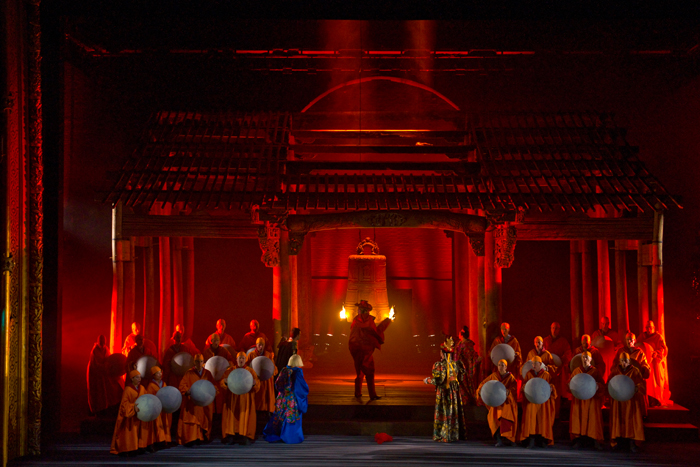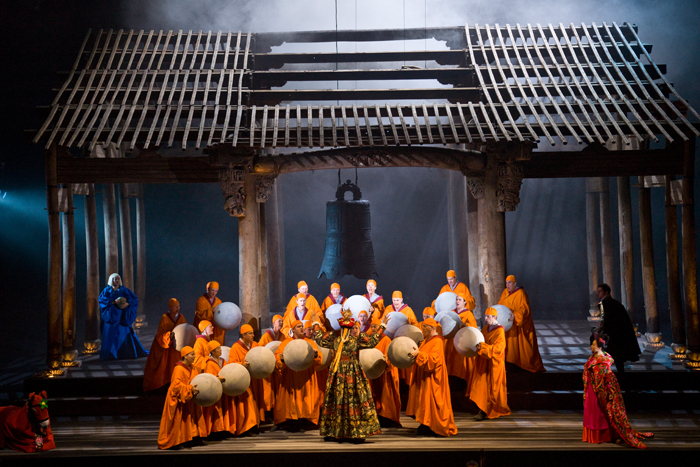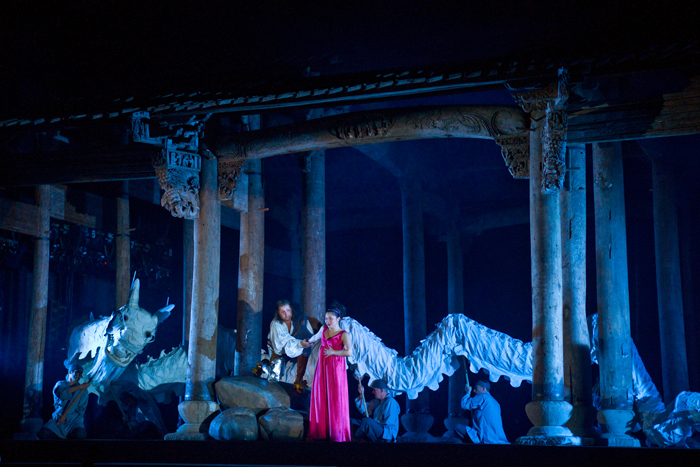-
Myth Manifest: Zhang Huan's Semele
By Carly AndersonPosted in 2011/2012[This article by Carly Anderson, children and youth programs manager at the COC, is currently available in the spring issue of our Prelude magazine. Watch the video above for an interview with Zhang Huan, the director of Semele]
Chinese artist Zhang Huan (interviewed on video above) rose to prominence on the international art scene in the 1990s with his iconoclastic and visceral “body experiments,” which recorded his body in extreme states of being. His first performances were a mixture of masochism and Taoist tests, which dealt with the vulnerability and fragility of corporeal experience. A classically trained painter, Mr. Zhang’s practice evolved to embrace more traditional forms of artistic creation including large-scale sculpture and painting. For his 2001 symbolic self-portrait “Peace Bell,” he created a large bell based on Tibetan temple models and inscribed it with the names of several generations of his ancestors. Beside it, a detailed cast of his body is suspended horizontally. The bell is rung when the artist’s effigy crashes into it head first, and the artist and the bell become one through an act of apparent violence. The common thread in Zhang’s work is the paradoxical nature of self-inflicted pain and the tension between physical transgression and the Buddhist-inspired quest for peace and enlightenment.

Semele (1743) – Zhang’s first directorial and design foray into lyric theatre – was composed by George Frideric Handel with a libretto by William Congreve as adapted from Ovid’s Metamorphoses. Daughter of the Theban King Cadmus, Semele is betrothed to the mortal Prince Athamas, but she is in love with the god Jupiter. His wife, Juno, having learned that her husband has built a palace for Semele, unleashes a plot to undo her. In a departure from the Ovidian myth, Juno calls upon Somnus, god of sleep, to cast Semele’s sister Ino into a deep sleep. Juno transforms into Ino, takes advantage of Semele’s naiveté, and plants the seeds of doubt that bring about Semele’s self-destruction. A covetous Semele offers Jupiter her body in return for immortality. Jupiter concedes and the mortal Semele is consumed by the god’s fire (read the full synopsis here). Zhang infuses this Greco-Roman myth with eastern iconography and philosophy, the centrepiece of which is a 450-year-old Ming Dynasty ancestral temple that Zhang discovered in a small town several hours west of Shanghai.
The disassembly and transportation of the temple to Zhang’s factory-sized Shanghai studio is documented in a video, which plays during the opera’s overture. In the video we learn that during the excavation of the temple, Zhang discovered several domestic relics including the diary of a man who lived in the temple about 20 years ago. The diary tells the story of the man’s beautiful wife, Ruan Jinmei, who was unfaithful to him. “A majority of the diary is written about his love and hate for his wife, and his sense of responsibility and helplessness for his family,” notes Zhang. In the end, the man murdered one of her lovers, resulting in his arrest and subsequent execution by firing squad.
Zhang was intrigued by the story’s similarity to the Ovidian myth and in a 2009 interview with The New York Times relayed: “I was amazed how this tale out of contemporary China was like the Greek tragedy, and it inspired me to do the production.” The central backdrop of this production – the ancestral temple – transforms through the incredible lighting design by Wolfgang Göebbel into both a marriage altar and Semele’s palace. The grandeur of the ornate wooden temple is complemented by Chinese-born fashion designer Han Feng’s luxurious costumes, made with colourful and patterned silks that recall traditional Chinese theatre, paired with Baroque tailoring.

Zhang successfully interweaves facets of Eastern and Western cultures and plays off the dualities, creating a narrative that is as contemporary as it is classical, and as much a part of Roman mythology as it is a story about human beings. Prior to the production’s 2009 debut at Théâtre de la Monnaie, Zhang said: “The fact that the roots of pain introduced hundreds of years ago in a Western opera reappear in the East, in the fate of a single peasant family in the countryside, can make us continually ponder the redemption of humanity.” Throughout Semele, Zhang weaves a multitude of narratives – the classical myth, the peasant family and his own personal iconography – all of which creates a story that is wholly different than what has preceded it.

Zhang has replaced the figure of Jupiter (traditionally signified by his white beard and lightning bolt) with the symbolic Chinese dragon. The opera does not conclude with Bacchanalian revelry and the marriage of Ino and Athamas, but instead with the image of the beautiful widow, Mrs. Ruan, mirrored back at us. In Zhang’s interpretation of Semele, the stress is not on the mythic. It is scaled back to focus on the human element – the single person. The mythic and the mundane, the sacred and the banal become one, and the myth is made manifest in our final glimpse of Ruan’s reflection.

First Photo: A scene from the Théâtre Royal de la Monnaie production of Semele. Photo © Karl Forster 2009
Second Photo: A scene from the Théâtre Royal de la Monnaie production of Semele. Photo © Karl Forster 2009
Third Photo: Jeremy Ovenden as Jupiter and Ying Huang as Semele in a scene from the Théâtre Royal de la Monnaie production. Photo © Karl Forster 2009
Fourth photo: Image of widow Ruan Jinmei created in the style of Zhang's series of "ash paintings," in which he paints with ash collected from temples around Shanghai to create vivid portraiture. Zhang considers the ash immaterial, a kind of collective soul or memory. Photo by Zhang Huan.
